Right-clicking in the Schematic view displays a context menu that contains options that are specific to the Schematic view.
Like the camera view context menu, the options in the Schematic view context menu change depending on what you click and on whether anything is selected.
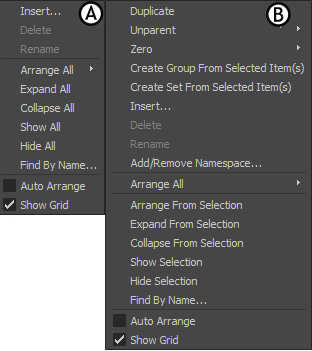
Schematic view context menus A. Menu available when right-clicking an empty space B. Menu available when one or more than one node is selected and you right-click
The Duplicate, Detach All Assets, Insert, Delete, and Rename options are common to both the Schematic and Camera views. See Viewer context menu for more information on these options.
The following are the options specific to the Schematic view context menu.
Arrange All
Organizes the display of all the nodes in the scene so that they are evenly spaced and easy to navigate. When no assets are selected, Arrange All repositions the hierarchy displays of the entire Schematic view.
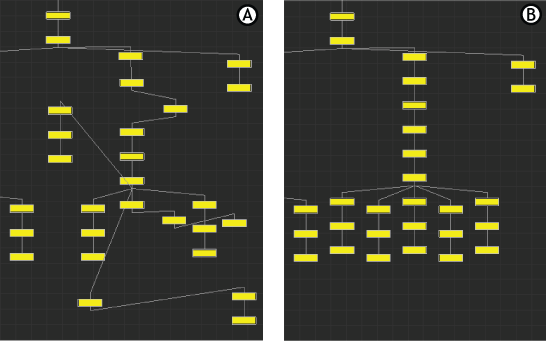
A. Disorganized hierarchy displayed B. Arrange All is activated
You can choose to display the node hierarchy of each object either horizontally (Arrange All > Horizontal), or vertically (Arrange All > Vertical) in the Schematic view area.
When you merge an .fbx file to another file, the saved arrangement of appended assets appears below all assets already showing in the Schematic view.
Arrange From Selection/Expand From Selection/Collapse From Selection
When one or more assets are selected, use options to reposition only the children of the selected node or nodes.

A. The hierarchy displayed is disorganized. One asset is selected. B. Arrange From Selection reorganizes only the selected asset and its children.
Expand All
Expands every hierarchy display that is collapsed.
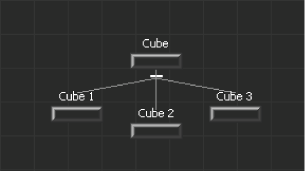
This hierarchy display is expanded. A minus sign displays under the root node “Cube.”
When one or more assets are selected, use Expand From Selection expands only the children of the selected node or nodes.
Collapse All
Collapses every hierarchy display so that only the root nodes remain visible.

This hierarchy display is collapsed. A plus sign displays under the root node “Cube.”
When one or more assets are selected, use Collapse From Selection to collapse only the children of the selected node or nodes.
Show All
Shows all assets in your scene. Use Show Selection to show only all selected assets.
For more information about parenting in the Schematic view, see Parenting and hierarchies and Display scene hierarchies using Schematic view.
Hide All
Hides all assets. Use Hide Selection to hide only selected assets. In the Schematic view, nodes that represent hidden assets display in dark gray.

A. All assets are shown, displaying in various colors. B. All assets are hidden, displaying in dark gray.
Find by Name
Lets you find an asset by searching for its name. The Find Model By Name window automatically includes an asset’s namespace. As you type in the search area, MotionBuilder generates a list of search results based on your search term you enter. Selecting any of the search results highlights the node in Schematic View.

The Find Model By Name dialog box
Auto Arrange
When the Auto Arrange option is enabled, it automatically repositions nodes in so that they are optimized and accessible. It is disabled by default.
For example, Auto Arrange can be useful when you are creating parent-child relationships.
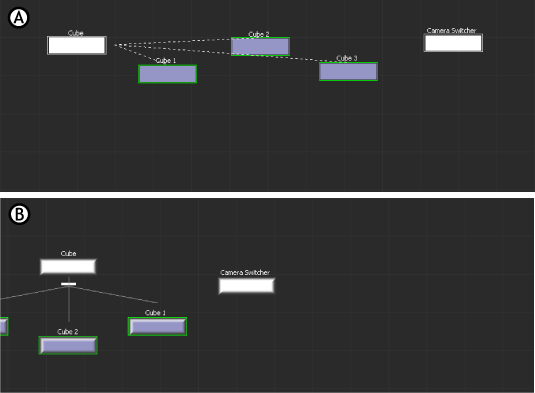
Auto Arrange is disabled. A. Cube 1, Cube 2, and Cube 3 are constrained to Cube. B. The child nodes move underneath the parent node, and do not display fully in the Viewer window.
When Auto Arrange is enabled, child and parent nodes are repositioned so that they do not overlap or move too far away when you are parenting.
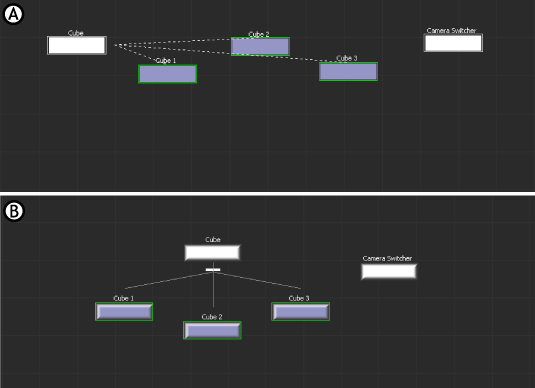
Auto Arrange is enabled. A. Cube 1, Cube 2, and Cube 3 are constrained to Cube. B. The child nodes move under the parent node, and the parent node is also repositioned.
Show Grid
The Show Grid option shows and hides the grid.